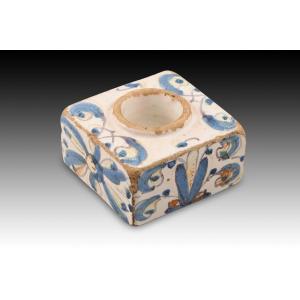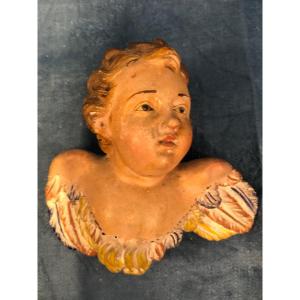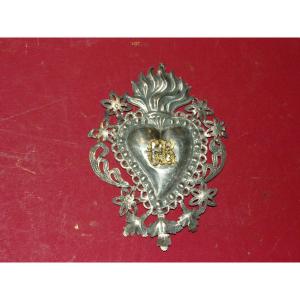Oil on canvas depicting a figurative scene inside a cave. On the right, a cross is seen standing upright, leaning against it; on the left, a hut; in the center of the painting, an elderly, bearded man appears, leaning on a table on which are a ceramic jar and a skull, with an open book at the foot of the table. The man is looking at a woman who is showing him something outside, accompanied by a large frog and a series of ghostly beings or monsters dressed in brightly colored robes and clothes. Saint Anthony the Abbot or Anthony the Great (251-356) was a Christian monk, considered the founder of the eremitic movement. He was tempted by the devil several times during his stay in the desert, which became a frequent theme in art (as can be seen in this oil painting). He is depicted in a black habit because the Order of the Knights of the Hospital of Saint Anthony (Hospitaliers) placed themselves under his patronage, this being the color of the habits of the members of this order (the tau or Egyptian cross was also the symbol chosen by them). David Teniers II or the Younger was a prominent Flemish painter and engraver, son of David Teniers the Elder or I and father of David Teniers III, highly appreciated in his time for his scenes of villagers and common people, his paintings of monkeys, etc. He treated the subject of the Temptations of Saint Anthony on numerous occasions: Prado Museum in Madrid, National Museum of Western Art (Tokyo, Japan), Wallraf-Richartz Museum (Cologne, Germany), etc. In the case of the present work, it is necessary to mention and compare it both with an oil kept in a private Parisian collection and with another sold at Christie's in 2018, from a Belgian collection, dated between 1630 and 1680 and signed. It should also be noted that engravings on this theme are known made from works by the painter (work at the Fine Arts Museum of San Francisco, United States of America, after Frans van der Wyngaerde and dated from the 17th century; at UCLA in California, United States of America, also after Frans van der Wyngaerde and from the 17th century). -
Dimensions: 52x4x47.5 cms. int: 42x35.5 cms






































 Le Magazine de PROANTIC
Le Magazine de PROANTIC TRÉSORS Magazine
TRÉSORS Magazine Rivista Artiquariato
Rivista Artiquariato